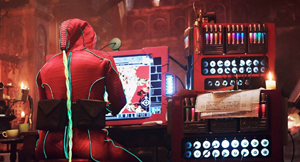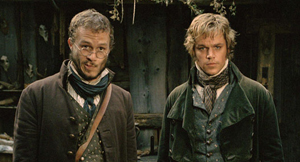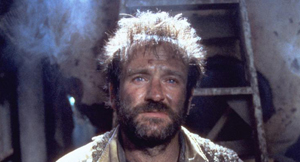One evening at the end of May 2013, as George Fenton was nearing the end of his work on The Zero Theorem, the composer spoke with Phil Stubbs.
Fenton has scored over seventy motion pictures over forty years, including THE FISHER KING for Terry Gilliam in 1991. The composer has developed long-lasting collaborations with a number of British filmmakers including Richard Attenborough, Stephen Frears and Ken Loach.
Terry Gilliam has described the score as extraordinary, and went on to say, “Without a doubt, without any hesitation, there is no other composer who could have done this so well. His music never draws attention to itself. It’s just floating in there, stroking the characters, and stroking the rhythms of the scenes.”
In the conversation below, Fenton discussed his inspirations and the methods used to complete the finished score.
| The score for The Zero Theorem is released for download by Milan Records on January 28 2014. A sample track is below, via SoundCloud. |

Phil Stubbs: At what stage was the project when you got involved?
George Fenton: Terry was just about to start shooting – it was probably about a week before. I think I got involved then because there were a couple of things to cover. Terry and I had a chat about Tilda doing her rap – but actually in the end she just chose something and rapped and it was fine.
Also, because the schedule of the film is quite short, and because he was going away to shoot, it was just as well that we met and said hello before he went off. But I didn’t really do anything until they came back and Mick Audsley started to get a cut together, and that’s when I started work… and that’s what I normally do anyway.
The production crew have said that when they came on board the project, Terry gave them visual references. Did Terry give you references in terms of what he wants from the score?
He gave me one or two references, for example when Qohen puts on the virtual reality suit and ends up on the beach, it should be like an old movie. But he was quite good at leaving me to find something of my own – and then he embraces it.
When you look at his work, it has a child-like enthusiasm and love of things. He is also incredibly inventive. When other people come in with other stuff, that they have invented, or made up or thought up or whatever, for him it’s more toys to play with. It’s like a new thing, he says “Great”. That’s quite empowering, actually it’s a very nice way to work.
The first time I worked with him, and definitely this time, it has been in part due to the influence of Ray Cooper in saying I could do it. Ray is very much around; he supports Terry in many ways, but in particular in music. It makes it quite easy, though I feel the pressure when I started but at the same time I know that if I come up with anything he’ll be welcoming. Terry embraces things. He’s not tight with his vision.
Was there anything else he handed over at the start?
Actually, he didn’t really need to because if you look at the film, you can see that what he’s doing: he is creating a world which is a projection or a thesis. So if you follow this logical thought, this is where you end up, so what could that be? The answer is it could be anything you want. And so if you look at it visually, it’s got an extraordinary mix of the gothic, the high-tech, the steampunk, the retro eighties – it’s all mixed up in a world that is uniquely his.
In a way, that’s quite hard to express. But I think the important part of a score with which people don’t really register terribly well is how the job of the score is there to tell the truth about the film. So in this film, I see what I think is the truth of the film and I write the music accordingly, and I place what I write accordingly: where it starts, what I emphasise, who I think is important in a scene, when they say it, what part of what they say I want to draw attention to.
By doing that, I give a reading of the film. Now if that is going to succeed, the most important thing is that I read it in the way that Terry sees it. And that takes a lot of thought, because he is so multifarious in his thinking, and he’s got such a wide palette of references. It’s fantastically energising and enjoyable.
[Editor] Mick Audsley said that he was worried about the amount of film time that was spent within the chapel; that the claustrophobia may harm the forward motion of the film. Was that a challenge to you also?
I think that those things are less of a challenge to me because by the time I come to the film, such problems have largely been dealt with, or someone has had to make a decision. So yes, that probably was something that was an issue, but I think the way the issue has been dealt with is to make the film more internalised as it has gone on. And so in a way it closes down.
So I see the chapel as Qohen’s universe; in a way it’s his womb as well. He begins to exist and people come to it, so the action takes place there. I think that would have been much more of a challenge for Mick, because when you start you’ve got to deal with the rushes, the balance of scenes and differences in light, wide shots etc. If you are constantly inside a dark space like a church, I could see that was something he would have to get his head around. But I think he did get his head around it.
Could you tell me about the process of putting this score together and what the stages were?
Obviously there is, inherent in the title, this unsolvable conundrum, and the attempts to realise it by him are done in front of a computer screen. So I thought that irrespective of the constraints of the budget – which are highly constraining actually – I thought that much of the score should be realised in an electronic way. Not to mean necessarily that it should be mechanical, but it should have electronics within it.
There’s also a wide-ranging, almost iconoclastic quality to the film; its attitude to the visuals seemed to be slightly Brechtian. I wondered if it should have a theatre band / Kurt Weill / kind of angular music. So I had these thoughts going around in my head, and then actually I developed a few bits and pieces in various parts of the film.
Normally I start with a scene that is central, and I work outwards from that scene. But I didn’t really do that on this one. I was trying to find the kinds of sounds and rhythms that would register on the face of Qohen/Christoph. What would make him the victim, what would make the world overwhelming, what would make the task frustrating, what could I do to him as a character, with the music, as in not to build him, but to contribute to his various predicaments? How would I represent the girl when she came in, how would I represent the boy, how would I represent Management?
Then in the middle of that, we were looking at reel one and Terry asked me, “What are we going to do about the party scene?” I said I didn’t know. They had some temporary music in: what they had in was songs, they were quite rocky really, and I said I could have a go.
In fact I started writing three tracks, dance tracks to the party. Loopy (by which I mean crazy rather than using loops), slightly wacky dance tracks. I found that when I wrote them, and when we chopped up the audio to make them like proper dance tracks, we found you could score the scene with the tracks. It could be fun if the tracks became part of the theme and became part of the score. Even though it was the dance track, it crossed over. And that was how I started. I did that part of reel one, and then I went back to the very front and I did the two or three bits leading up to that and I had a reel.
Every score is different of course, but every score emerges like that. You live with the thing for a long time, and you are with it 24 hours a day. You are just waiting for the moment, or the thing that says: you are going to start here. It says it to you: something happens. What’s the main theme going to be? What’s her music going to be? Or what’s his music going to be? You do that one thing and that becomes the germ, but you don’t necessarily know, when you are living with the film, what that thing is going to be that’s going to get you going.
You’ve got to find it…
Or let it find you! That’s not a very good answer for you, because there is no format! It’s different with every picture, the other thing that makes it different is that when you start, it depends how finished the picture is. If the picture is rhythmically scene order, length, finished… then you probably feel very comfortable about the journey you are going to make: you can see the beginning, middle and end of it. But if you start on a film where you don’t know necessarily whether it’s going to end that way or what might happen or if something about the order is going to change… then it changes what you know. In some ways it makes it more interesting. You are not sure necessarily where you are going to end up. But you have to start.
You mentioned electronic music, is any of the score a more industrial sound, with distortion?
Yes, some of it is sound-design sounds, and some electronics. Little sine wave sounds, with delays like copying tracks and offsetting them. And some of it is samples. And then some of it, the beach scenes for example, and those at the end of the film, I couldn’t really see how I could do that unless I had real instruments. There are in fact four big moments where I used a small string orchestra.
For the non-orchestra tracks, are you recording the layers using a keyboard?
Yes, programming and recording them, and I sometimes added solo instruments. Whatever I do, I record them as multitracks, and then they are mixed by an engineer. Sonically they are like live recordings. I can’t really explain what the sound is, but it’s not what I’d call avant-garde sound design, and it’s not what I would call a pure groove-based electronic stuff like The Social Network, that kind of score.
The demands of a score for a film like The Social Network are totally different than on a film like this. The Social Network is a highly accessible story about a highly accessible person: we all know the story. Whereas this is a highly inaccessible story! We have no idea who he is or what he’s doing, or where he is. So in a way the music has to have enough colour, range and fluidity to articulate things that hopefully make scenes play in an accessible way. That’s the attempt. There’s a lot of music in this film, which I didn’t think when I first saw it.
How do you ensure that what you are coming up with is what Terry is happy with?
Only by playing it to him… If it doesn’t click with him, I just do it again!
For you what has been the most rewarding thing about this picture?
The most rewarding thing, I would say, is the twists and turns of the story in the midst of this incredibly rich visual film. To write music for something where in every frame there is so much visual richness, it’s the invention on the screen that makes it absolutely great to write for.
And the people who you work with, nothing is worth doing unless you are doing it with people you admire. Terry is the guv’nor when it comes to invention.
POSTSCRIPT
Terry Gilliam highlighted a further benefit from using electronic music, adding, “George composed beautiful romantic music for the beginning of the beach scene which I thought was perfect, but when we got into the dubbing theatre we realised the scene demanded something different. Normally, with a real orchestra, this would have been impossible to alter in the time available, but George said, ‘Leave it to me,’ and came back the next morning with a freshly composed, utterly brilliant Hawaiian guitar cue. The restriction of working with electronic music allowed us the freedom to solve a problem overnight.”
















